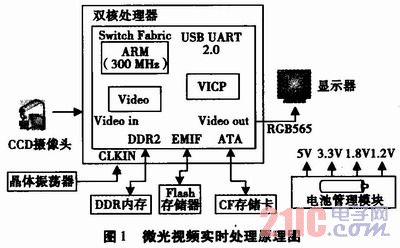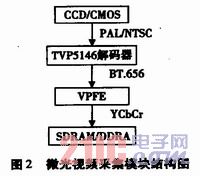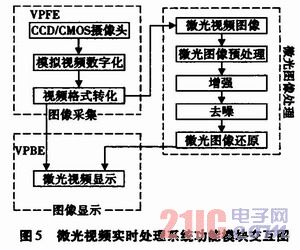Abstract: In-depth study and analysis of low-light video enhancement technology, in order to solve the real-time processing capability of low-light video, combined with the technical characteristics of the Delphich platform to design an image enhancement system based on the TMS320DM6446 platform for low-light video real-time processing system to realize low-light video The system's real-time acquisition, real-time processing and real-time display module, and finally through the test processing results and real-time testing, the system design meets the requirements.
Keywords: Da Vinci platform; low-light video; data acquisition; embedded
O Introduction The low-light video system is more and more widely used in night vision technology. However, due to the low target illumination, the close target and background reflection coefficient, and the poor observation environment, the obtained low-light video image is always Not satisfactory results. Under the condition of China's existing hardware production capacity, the low-light image intensifier can not achieve the application effect, but the real-time image processing technology can quickly improve the image quality of the low-light system and increase the line-of-sight of the low-light video system. Combining real-time image processing technology with image enhancement technology has become an important development direction to shorten the gap between domestic and international low-light video systems. This paper implements a real-time processing system for low-light video on the DaVinci platform TMS320DM6446, which is a low-light video for China. System design has important reference value.
1 Low-light video enhancement technology The most notable feature of low-light video is that there is obvious random flicker noise superimposed on the image. By analyzing the characteristics and noise of the low-light video, the contrast and reduction of the low-light video can be increased. The low-light video noise is designed in two aspects to design a low-light video augmentation system. Due to the characteristics of the system, a simple and effective processing algorithm is required. Histogram equalization is a classical algorithm for increasing image contrast, and the algorithm is simple and the processing effect is good. The Gaussian smoothing algorithm can effectively remove the high-frequency components of the image and preserve the low-frequency components. These two algorithms are used in conjunction with the embedded processing platform. , can get very good results. This paper uses software design methods to achieve image enhancement techniques in design.
2 The micro-optical video system based on the DaVinci platform is characterized by real-time acquisition and real-time display, which realizes enhanced processing and denoising processing of low-light video, achieving real-time processing requirements, so it needs to be stronger. Real-time processing and data processing capabilities, here choose TI's DaVinci platform (TMS320DM6446) with DSP + ARM dual-core processing capabilities to meet the above requirements.
In the low-light video real-time processing system, the acquisition, processing and display process of the low-light video is performed by the CCD/CMOS camera or the image decoder on the TMS320DM6446 platform, and the low-light video is collected in real time and digitally converted and stored in the read buffer. The user can use the digital media processor of TMS320DM6446 to complete the real-time processing task of the low-light video, and display the processed low-light video through the display device on the embedded processing platform for real-time display. The principle of the low-light video real-time processing system is shown in Figure 1. 
In the low-light video real-time processing system, the real-time acquisition part of the low-light video is completed by the video acquisition device and the video decoding chip; the real-time processing of the low-light video is completed by TI's TMS320 DM6446 dual-core processor; the low-light video real-time output system consists of The LCD display and video encoder are completed.
2.1 Acquisition of low-light video images The analog video digitization standard ITU-RBT. 656, it is at ITURBT. A new video digitization standard developed by 601 (CCIR-601). Since the CCIR656 video data stream uses 8 signal lines (19 signal lines are required in the conventional way), all image information and line synchronization, field synchronization, and even synchronization information can be transmitted. Therefore, the CCIR656 method is used for interface design, which facilitates real-time digital images. The processing hardware platform is modularized in units of functional units. 
Acquired analog low-light video through CCD/CMOS video capture device, the video is PAL or NTSC, and the analog video passes the decoding chip TVP5146 and CCD controller BT. The 656 interface performs A/D conversion and converts the video into YCrCb format. At the same time, the collected low-light video is buffered in the read buffer of DDRAM or SDR-AM through an external memory interface (EMIF) for dimming. The video processing module processes the collected data.
2.2 The design of the low-light video processing function is based on the video format, and then the component is converted from the RGB format to the YUV format, and then the component is processed in the embedded processing platform, and the component is used instead of the Y component after the processing is completed. Converts a grayscale image into a color image for output and other operations. The structure of the video processing module is shown in Figure 3. 
After the acquisition module collects a frame of low-light video, the video processing module acquires a frame of low-light video from the read buffer (Read Buffer) in the DDRAM/SDRAM, and sequentially performs enhancement and denoising processing on the low-light video, and processes again. It is cached in the Write Buffer in DDRAM or SDRAM for use by the display module.
2.3 Design of the low-light video display function In this system, we use Framebuffer technology and DaVinci's video processing subsystem VPSS technology to display the image. Framebuffer is a frame buffer, which is a driver interface in the Linux kernel. This interface abstracts the display device into a frame buffer. Users can think of it as an image of the display memory without having to care about the location of the physical memory, the page-changing mechanism and so on. Because these details are all driven by the Framebuffer device. The programmer simply displays the image to be displayed into the process address space and it is displayed on the screen. The structure of the display module is shown in Figure 4. 
After the video captured by the acquisition module is processed by the processing module for enhancement and noise reduction, it uses the memory mapping method to display using FrameBuffer technology.
3 low-light video real-time processing system software design Because DM6446 integrates ARM and DSP dual-core, ARM terminal is the main control device, DSP side is used to process image processing, which greatly improves the processing power of the system. The system can be divided into three parts: the low-light video acquisition module, the low-light video processing module and the low-light video display module. The system starts to collect the low-light video by the video acquisition device, and the collected analog video image is passed. BT. 656 standard digitization, storing the digitized low-light video in the read buffer of SDRAM/DDBAM for use by the low-light video processing module; the low-light video processing module reads the low-light video from the read buffer and The video is preprocessed, the fitting component to be processed is extracted, and then the component is subjected to enhancement processing and denoising processing. After processing, the grayscale image is restored to a color image and written into a write buffer in SDRAMIDDRAM for display. The module performs display; the function of the low-light video real-time processing system is shown in Figure 5. 
4 System Test The implementation part is tested on the DaVinci platform TMS320DM6446. Real-time processing is realized on the basis of real-time acquisition and real-time display. The results of each module test are as follows. The original low-light video captured is shown in Figure 6. 
Figure 6 is an original image of a low-light video system. It can be seen that the image contrast is relatively low and there is particle noise on the surface. The real-time test results of video acquisition based on TMS320DM6446 platform are shown in Table 1. It can be seen that when the image processing algorithm is added, the video acquisition reaches 25fps, real-time requirements are met, CPU utilization and video in ARM and DSP. The bit rate is shown in Table 1. 

This article refers to the address: http://
Figure 7 is a real-time processing test of low-light video based on real-time acquisition. For the acquired one-frame low-light video, the image processed by the enhancement algorithm of this paper is used. 
Figure 7 shows the enhancement effect of the low-light video. The real-time test of the low-light video processing is shown in Table 2. After the acquisition and processing, the video is displayed at a speed of 24fpe, which basically meets the requirements of real-time performance. The video bit rate is shown in Table 2.
From Figures 6 to 7 and Tables 1-2, it can be found that the system is enhanced in image processing capability and system CPU utilization compared to the original system, achieving the ability of the micro-light system to process.
5 Conclusion The DaVinci platform integrates a general-purpose processor and a digital signal processor dual core. Compared with the previous single-core processing platform, it has higher performance and lower power consumption, both in computing power and in control. Functionally, the requirements can be met. The design of the low-light system presented in this paper has important reference value for the design of related video processing systems.
The material of this product is PC+ABS. All condition of our product is 100% brand new. OEM and ODM are avaliable of our products for your need. We also can produce the goods according to your specific requirement.
Our products built with input/output overvoltage protection, input/output overcurrent protection, over temperature protection, over power protection and short circuit protection. You can send more details of this product, so that we can offer best service to you!
Lcd Adapter,Mini Size Lcd Adapter,Security Lcd Adapter,Waterproof Lcd Adapter
Shenzhen Waweis Technology Co., Ltd. , https://www.huaweishiadapter.com